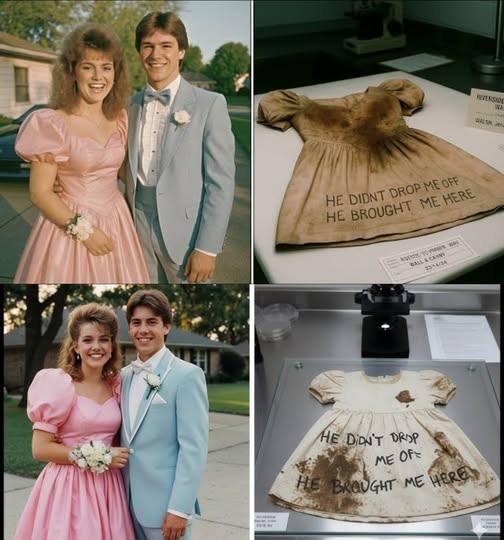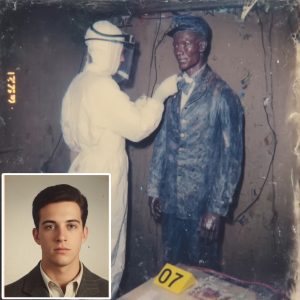Teen Vanished After Prom 1985 — 39 Years Later Her Dress Found in Wall With Message Sewn in Blood…
March 14th, 2024 — Springfield, Ohio.
The old textile factory had stood silent for years, its broken windows staring out like hollow eyes. When the demolition crew arrived that morning, they thought it would be just another teardown — dust, debris, and concrete. But what they found behind one crumbling wall would send shockwaves through the town.
As Miguel Santos swung his sledgehammer into a decayed section of the second-floor wall, the plaster cracked open with a dull thud. Something soft fell to the floor — not debris, not insulation. Fabric. Pink fabric. Miguel bent down, brushing away the dust, and froze. It was a dress. A prom dress. Puffy sleeves, satin sheen dulled by time, and streaked with dark brown stains that looked disturbingly like dried blood.
At first, he thought maybe it was a prank — some leftover costume or forgotten prop. But then his supervisor turned the dress inside out and saw the stitching. Words — sewn by hand with shaking precision, the thread dark and uneven, as if dyed with something that wasn’t ink.
“Jennifer Walsh. He didn’t drop me off. He brought me here.”
The room went silent. Miguel dropped the dress. The factory that had stood empty for years suddenly felt alive — heavy, watching. When police arrived, they quickly realized this wasn’t just a piece of old clothing. It was a cry for help — one left behind nearly four decades earlier.
And within hours, detectives would reopen one of Springfield’s oldest cold cases — the disappearance of Jennifer Walsh, the girl in the pink dress who vanished on prom night, 1985…

Detectives sealed off the factory within minutes. Dust still hung in the air like fog, and every step echoed in the cavernous darkness. Forensic techs worked in silence, carefully photographing the dress — the same pink satin Jennifer Walsh had been wearing in the only prom photo her mother still kept framed on her mantel.
Jennifer Walsh. Age 17. Vanished May 18, 1985.
One moment she was dancing with friends at Springfield High’s prom…
The next, she stepped outside to wait for her date — and was never seen again.
For thirty-nine years, the case had gone nowhere.
But now, inside this forgotten ruin, her voice had been found — literally sewn into the very fabric of her final hours.
The detectives spread out through the second floor. Near the far wall, beneath a collapsed rafter, someone noticed something odd — a patch of wallpaper that bulged slightly outward. It didn’t match the rest. It was newer. Cleaner.
“When was this installed?” Detective Rowan asked.
“Not part of the factory’s original structure,” the crime-scene analyst replied. “Looks like someone patched this over sometime in the late 80s.”
Rowan’s stomach sank. “Open it carefully.”
The crew peeled the wallpaper back. Then the boards behind it.
Then the smell hit.
A hollow space.
No larger than a closet.
Sealed from the outside world.
And inside… bones.
A girl-sized skeleton, still wearing the remains of a corsage — plastic petals fused to decayed wrist bones. Satin scraps clung to fragments of ribs. A single silver shoe lay near the skull.
No doubt remained.
Jennifer Walsh had been hidden here for 39 years.
As the techs worked, Rowan noticed something else — fabric clenched in the skeleton’s hand. It was stiff, brittle, fused to bone.
He knelt.
Not fabric.
Not cloth.
A strip of suit lining.
Black. Expensive. Custom-made.
He turned it over — part of a tailor label still clung to it.
And then he saw the initials sewn into the lining:
H.W.
Rowan felt the air drain from his lungs.
Half the town would recognize those initials.
H.W. — Harold Whitaker.
Prom chaperone that night.
Beloved history teacher.
The man who led Jennifer’s original search efforts.
The man who delivered a trembling speech at her vigil.
The man who had retired with honors in 2008.
The man who had died peacefully in his sleep last winter at age 84… mourned by the whole community.
But the worst discovery was still to come.
Back at the lab, forensic analysts carefully examined the message sewn into Jennifer’s dress. At first glance, it looked like jagged stitching, letters formed in panic. But under magnification, the truth became clear:
The thread was blood.
Hers.
But there was something else — smaller stitches beneath the larger ones. A second layer of thread.
“Ma’am,” the tech whispered to Rowan, trembling, “the dress… the message… it isn’t complete.”
They snipped through the first line.
Underneath, written in smaller, more frantic letters:
“He locked me in the wall. I can hear him coming back. Please don’t let him—”
The sentence ended abruptly.
The needle must have slipped from her numb fingers.
Jennifer Walsh had sewn her last words into her own dress… in the dark… alone… as the man who’d abducted her sealed her inside the wall alive.
That evening, Springfield held an emergency press conference. News crews poured in from every direction.
The police chief’s voice cracked as he spoke:
“We believe Jennifer Walsh was confined while still alive. The evidence indicates she attempted to communicate what happened… in her final hours.”
Her family wept openly.
Reporters kept asking the same question:
How could Harold Whitaker hide her for thirty-nine years?
The answer would come the next morning when investigators searched his now-abandoned home. In the basement they found:
Blueprints of the textile factory.
A box of women’s shoes.
And, in a sealed drawer,
three more prom corsages.
Untouched.
Preserved.
Waiting.
Jennifer Walsh had been his last victim…
but not his first.
Springfield had worshipped a monster and never knew it.
The town held a memorial service for Jennifer a week later.
Her reconstructed dress — pink satin, blood-stitched confession still preserved — sat inside a glass case at the front of the church. Thousands came.
And on the plaque beneath it were the words she had fought so desperately to leave behind:
“He didn’t drop me off.
He brought me here.”
After 39 years, her voice had finally been heard.
And Springfield would never forget it.





